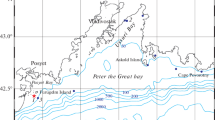Abstract
Response of the barotropic western boundary current to typhoon passage is investigated by the use of the numerical models described in Part I. Steady states obtained in Part I are chosen as the initial conditions for undisturbed currents. In these models it is assumed that an axially symmetric typhoon (radius = 100 km, maximum wind speed = 27.4 m/sec) moves parallel to the western boundary.
For the model with a flat bottom the boundary flow diminishes its strength and broadens its width after the passage of the typhoon offshore. For the model with a continental slope the effect of the typhoon is significantly different depending on the distance of the path of the typhoon from the western boundary. Specifically the north wind on the continental slope causes the formation of cyclonic vortex, which progresses southwards along the slope in the northern hemisphere. Linear theory of continental shelf waves indicates that the phase speed of the propagation of the vortex is 2.4 m/sec. Anomalies of the water level along the coast are also calculated from geostrophic relationships.
Similar content being viewed by others
References
Adams, J. K., andV. T. Buchwald (1969): The generation of continental shelf waves. J. Fluid Mech.,35, 815–826.
Buchwald, V. T., andJ. K. Adams (1968): The propagation of continental shelf waves. Proc. Roy. Soc. London.A., 305, 235–250.
Charney, H. G. (1955): The generation of ocean currents by wind. J. Marine Res.,14, 477–498.
Endoh, M., andT. Nitta (1971): On Rossby waves forced by travelling atmospheric disturbances in a barotropic bounded ocean. J. Meteor. Soc. Japan,49, 137–145.
Endoh, M., (1973): A numerical experiment on the variations of western boundary currents. Part I. J. Oceanog. Soc. Japan,29, 16–27.
Isozaki, I. (1969): An investigation on the variations of sea level due to meteorological disturbances on the coast of Japanese Islands (III). J. Oceanog. Soc. Japan,25, 91–102.
Isozaki, I. (1972): personal communications.
Kajiura, K. (1959): A theoretical and empirical study of storm induced water level anomalies. Tech. Rept., A & M College of Texas, R-56-23F.
Kajiura, K. (1962): A note on the generation of boundary waves of Kelvin type. J. Oceanog. Soc. Japan,18, 49–58.
Longuet-Higgins, M. S. (1965): The response of a stratified ocean to stationary or moving wind-systems. Deep Sea Res.,12, 923–973.
Longuet-Higgins, M. S. (1968a): On the trapping of waves along a discontinuity of depth in a rotating ocean. J. Fluid Mech.,31, 417–434.
Longuet-Higgins, M. S. (1968b): Double Kelvin waves with continuous depth profiles. J. Fluid Mech.,43, 49–80.
Rhines, P. B. (1970): Edge-, bottom-, and Rossby waves in a rotating stratified fluid. Geophys. Fluid Dyn.,1, 273–302.
Robinson, A. R. (1964): Continental shelf waves and the response of sea level to weather systems. J. Geophys. Res.,69, 367–368.
Veronis, G. (1958): On the transient response of aΒ-plane ocean. J. Oceanog. Soc. Japan,14, 1–5.
Veronis, G. andH. Stommel (1957): The action of variable wind stress on a stratified ocean. J. Marine Res.,15, 43–75.
Yoshida, K., D. Shoji, andJ. Masuzawa (1972): A possible interaction between the storm tides and the Kuroshio—A speculation on the recent floods. Rec. Oceanog. Works in Japan,11, 47–51.
Author information
Authors and Affiliations
Rights and permissions
About this article
Cite this article
Endoh, M. A numerical experiment on the variations of western boundary currents: Part II. Response to a moving typhoon. Journal of the Oceanographical Society of Japan 29, 28–43 (1973). https://doi.org/10.1007/BF02109586
Received:
Issue Date:
DOI: https://doi.org/10.1007/BF02109586




